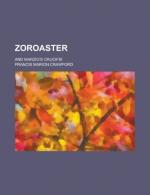But the Greek slave-woman stood with Zoroaster’s letter in her hand and held the gold piece he had given her in her mouth, debating what she should do. She was one of the queen’s women, as it chanced, and she immediately reflected that she might turn the writing to some better account than by delivering it to Nehushta, whom she had seen for a moment that morning as she passed, and whose dark Hebrew face displeased the frivolous Greek, for some hidden reason. She thought of giving the scroll to the queen, but then she reflected that she did not know what it contained. The words were written hastily and in the Chaldean character. Their import might displease her mistress. The woman was not a newcomer, and she knew Zoroaster’s face well enough from former times; she knew also, or suspected, that the queen secretly loved him, and she argued from the fact of Zoroaster, who was dressed for a journey, sending so hastily a word to Nehushta, that he loved the Hebrew princess. Therefore, if the letter were a mere love greeting, with no name written in it, the queen might apply it to herself, and she would be pleased; whereas, if it were in any way clear that the writing was intended for Nehushta, the queen would certainly be glad that it should never be delivered. The result of this cunning argument was that the Greek woman thrust the letter into her bosom, and the gold piece into her girdle; and went to seek an opportunity of seeing the queen alone.
That day, towards evening, Atossa sat in an inner chamber before her great mirror; the table was covered with jade boxes, silver combs, bowls of golden hair-pins, little ivory instruments, and all the appurtenances of her toilet. Two or three magnificent jewels lay among the many articles of use, gleaming in the reflected light of the two tall lamps that stood on bronze stands beside her chair. She was fully attired and had dismissed her women; but she lingered a moment, poring over the little parchment scroll her chief hairdresser had slipped into her hand when they were alone for a moment. Only a black fan-girl stood a few paces behind her, and resting the stem of the long palm against one foot thrust forward, swung the broad round leaf quickly from side to side at arm’s length, sending a constant stream of fresh air upon her royal mistress, just below the level of the lamps which burned steadily above.
The queen turned the small letter again in her hand, and smiled to herself as she looked into the great burnished sheet of silver that surmounted the table. With some difficulty she had mastered the contents, for she knew enough of Hebrew and of the Chaldean character to comprehend the few simple words.
“I go hence for twelve days upon the king’s business. My beloved, my soul is with thy soul and my heart with thy heart. As the dove that goeth forth in the morning and returneth in the evening to his mate, so I will return soon to thee.”
Atossa knew well enough that the letter had been intended for Nehushta. The woman had whispered that Zoroaster had given it to her, and Zoroaster would never have written those words to herself; or, writing anything, would not have written in the Hebrew language.




